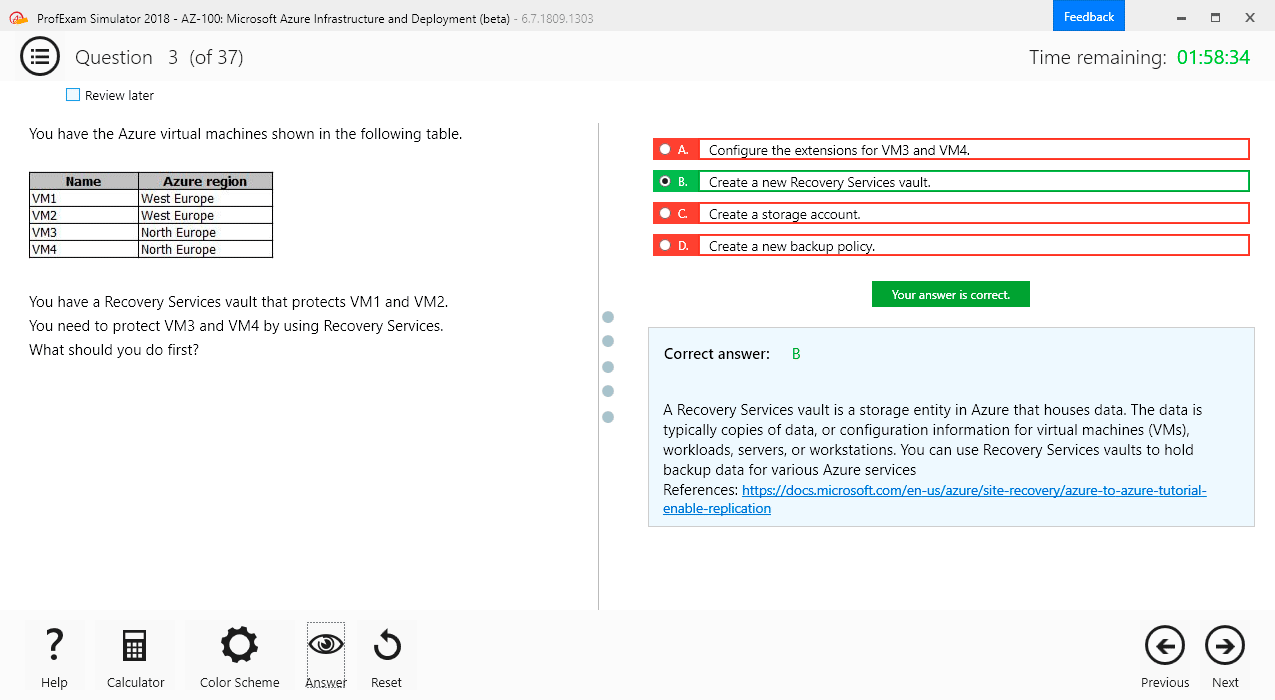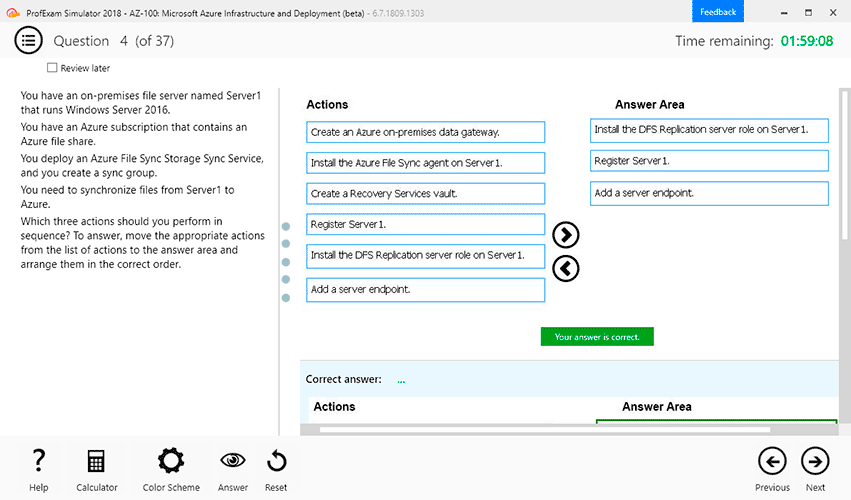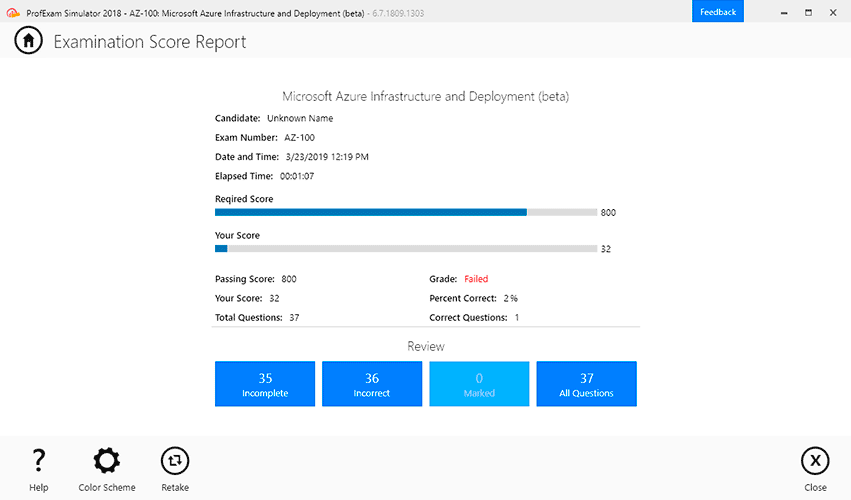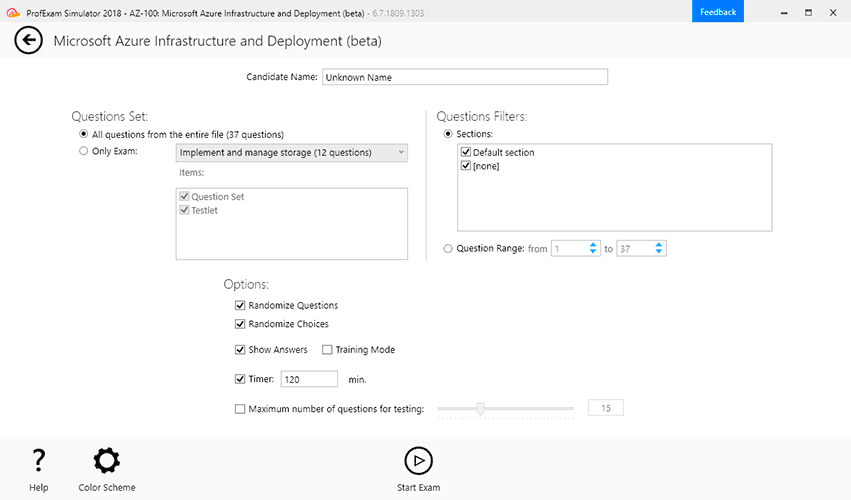File Info
| Exam | IBM Storage Technical V1 |
| Number | C9020-668 |
| File Name | IBM.C9020-668.Lead2Pass.2019-01-12.70q.vcex |
| Size | 131 KB |
| Posted | Jan 12, 2019 |
| Download | IBM.C9020-668.Lead2Pass.2019-01-12.70q.vcex |
How to open VCEX & EXAM Files?
Files with VCEX & EXAM extensions can be opened by ProfExam Simulator.
Coupon: MASTEREXAM
With discount: 20%





Demo Questions
Question 1
A customer needs to import and export volumes between IBM Spectrum Virtualize clusters that are geographically separated.
How can this be accomplished?
- Create image mode volumes
- Snapshots with Transparent Cloud Tiering
- Implement IBM Spectrum Archive
- Utilize tiering-to-tape media
Correct answer: B
Explanation:
Transparent cloud tiering is a licensed function that enables volume data to be copied and transferred to cloud storage. The system supports creating connections to cloud service providers to store copies of volume data in private or public cloud storage. With transparent cloud tiering, administrators can move older data to cloud storage to free up capacity on the system. Point-in-time snapshots of data can be created on the system and then copied and stored on the cloud storage. References: https://www.ibm.com/support/knowledgecenter/en/STVLF4_7.8.1/spectrum.virtualize.781.doc/svc_icoverviewtranparentcltier.html Transparent cloud tiering is a licensed function that enables volume data to be copied and transferred to cloud storage. The system supports creating connections to cloud service providers to store copies of volume data in private or public cloud storage.
With transparent cloud tiering, administrators can move older data to cloud storage to free up capacity on the system. Point-in-time snapshots of data can be created on the system and then copied and stored on the cloud storage.
References: https://www.ibm.com/support/knowledgecenter/en/STVLF4_7.8.1/spectrum.virtualize.781.doc/svc_icoverviewtranparentcltier.html
Question 2

Which component of IBM Spectrum Scale enables data to be imported from several servers at the same time?
- HDFS Transparency connector
- IBM Spectrum Protect integration
- Cloud Object Storage support
- Multi-Cluster feature
Correct answer: B
Explanation:
With Spectrum Scale multiple Spectrum Protect instances use the same storage Capacity and performance management is seamless within a global name space Scalability is seamless and transparent File system replication is integrated with Spectrum Scale for different platforms Central administration of TSM storage Note: Multiple Spectrum Protect (TSM) instances store DB and storage pools in a Spectrum Scale file system (GPFS)Spectrum Scale provides global name space for all Spectrum Protect instances Instances share all file system resources Spectrum Protect instances run on cluster nodes accessing the file system and disk directly Spectrum Scale file systems balances the workload and capacity for all TSM instances on disk Provides standardized, scalable and easy to use storage infrastructure for the multiple instances Incorrect Answers:A: IBM Spectrum Scale HDFS transparency offers a set of interfaces that allows applications to use HDFS Client to access IBM Spectrum Scale through HDFS RPC requests.References: https://www-03.ibm.com/support/techdocs/atsmastr.nsf/5cb5ed706d254a8186256c71006d2e0a/3264fd1e3716c13586257f460072493d/$FILE/SpectrumProtect_on_Spectrum%20Scale_Intro_v6.3.pdf With Spectrum Scale multiple Spectrum Protect instances use the same storage
- Capacity and performance management is seamless within a global name space
- Scalability is seamless and transparent
- File system replication is integrated with Spectrum Scale for different platforms
- Central administration of TSM storage

Note: Multiple Spectrum Protect (TSM) instances store DB and storage pools in a Spectrum Scale file system (GPFS)
- Spectrum Scale provides global name space for all Spectrum Protect instances
- Instances share all file system resources
- Spectrum Protect instances run on cluster nodes accessing the file system and disk directly
- Spectrum Scale file systems balances the workload and capacity for all TSM instances on disk
- Provides standardized, scalable and easy to use storage infrastructure for the multiple instances
Incorrect Answers:
A: IBM Spectrum Scale HDFS transparency offers a set of interfaces that allows applications to use HDFS Client to access IBM Spectrum Scale through HDFS RPC requests.
References: https://www-03.ibm.com/support/techdocs/atsmastr.nsf/5cb5ed706d254a8186256c71006d2e0a/3264fd1e3716c13586257f460072493d/$FILE/SpectrumProtect_on_Spectrum%20Scale_Intro_v6.3.pdf
Question 3
A customer asks about the implication of replacing a current tape library with a single disk-only IBM TS7760.
Which key point should the technical specialist address?
- Validate that the new virtual library emulates the correct drive type.
- Confirm the compression ratio on the tapes to calculate the disk space needed.
- Identify the current provision for tape vaulting and disaster recovery.
- Check whether current tape media is encrypted.
Correct answer: A
Explanation:
The TS7700 is a member of the TS line of products and builds upon previous implementations of tape storage virtualization. For example, the TS1155 Tape drive is not compatible with IBM TS7700 or Enterprise Tape Control Unit environments. References: http://www.redbooks.ibm.com/redbooks/pdfs/sg245946.pdf, IBM Tape Library Guide for Open Systems (August 2017), page 127 The TS7700 is a member of the TS line of products and builds upon previous implementations of tape storage virtualization.
For example, the TS1155 Tape drive is not compatible with IBM TS7700 or Enterprise Tape Control Unit environments.
References: http://www.redbooks.ibm.com/redbooks/pdfs/sg245946.pdf, IBM Tape Library Guide for Open Systems (August 2017), page 127
Question 4
A customer wants to replace an existing HDS system connected to an IBM z/OS mainframe with a storage solution to reduce cooling requirements and potential of mechanical failure.
Which storage solution should the technical specialist recommend?
- IBM FlashSystem 900
- IBM FlashSystem V9000
- IBM DS8886 HPFE
- IBM DS8884 with SAS drives
Correct answer: D
Explanation:
IBM invented the z Systems I/O architecture. Systems, SAN and DS8880 are jointly developed. IBM invented the z Systems I/O architecture. Systems, SAN and DS8880 are jointly developed.
Question 5
A customer has existing SAP HANA production nodes connected to an IBM Elastic Storage Server (ESS). The customer needs to scale out additional ESS nodes to maintain the high I/O throughput requirement.
Which type of nodes should be proposed?
- Storage nodes with SAS drives
- Storage nodes with SSD drives
- Protocol nodes with SAS drives
- Protocol nodes with SSD drives
Correct answer: B
Explanation:
A scale-out NAS system is comprised of multiple NAS storage nodes with internal or external storage. Each NAS storage node represents the same file systems to user applications. Data is stored across all NAS storage nodes, and adding capacity can be achieved by adding more storage nodes. References: https://www-03.ibm.com/systems/storage/spectrum/scale/scale-out-nas.html A scale-out NAS system is comprised of multiple NAS storage nodes with internal or external storage. Each NAS storage node represents the same file systems to user applications. Data is stored across all NAS storage nodes, and adding capacity can be achieved by adding more storage nodes.
References: https://www-03.ibm.com/systems/storage/spectrum/scale/scale-out-nas.html
Question 6
An IBM DS8886 customer wishes to replicate data from the primary data center to a new secondary data center 310 miles (500km) away while maintaining a low recovery point objective.
Which offering should the technical specialist recommend?
- SnapMirror
- Metro Mirror
- Global Mirror
- FlashCopy
Correct answer: C
Explanation:
Global Mirror is a long-distance remote copy function across two sites using asynchronous technology. Global Mirror processing is designed to provide support for virtually unlimited distance between the local and remote sites, with the distance typically limited only by the capabilities of the network and the channel extension technology. Incorrect Answers:B: Metro Mirror provides real-time mirroring of logical volumes between two DS8000 storage units that can be located up to 300 km from each other.References: https://www.ibm.com/support/knowledgecenter/en/HW213_7.1.0/com.ibm.storage.ssic.help.doc/f2c_copysgintro_1xiohq.html Global Mirror is a long-distance remote copy function across two sites using asynchronous technology. Global Mirror processing is designed to provide support for virtually unlimited distance between the local and remote sites, with the distance typically limited only by the capabilities of the network and the channel extension technology.
Incorrect Answers:
B: Metro Mirror provides real-time mirroring of logical volumes between two DS8000 storage units that can be located up to 300 km from each other.
References: https://www.ibm.com/support/knowledgecenter/en/HW213_7.1.0/com.ibm.storage.ssic.help.doc/f2c_copysgintro_1xiohq.html
Question 7
A customer has existing fiber attached storage that has reached the end of life. The customer wants a scalable solution that is easy to manage and integrates with VMware. The customer prefers an IBM A9000R based solution, but is concerned about migrating the virtual machines and ESX boot volumes.
Which explanation addresses the customer’s concern?
- Use VMware Storage vMotion to migrate virtual machines and boot volumes.
- IBM A9000R has both a vCenter and VAAI plug in.
- Use IBM Spectrum Control to virtualize and move existing storage to the new IBM A9000R.
- IBM A9000R has a built in capability to copy the existing data.
Correct answer: A
Explanation:
VMware VMotion: Allows the live migration of running VMs from one physical server to another, one data store to another, or both. This migration has zero downtime, continuous service availability, and complete transaction integrity.References: http://www.redbooks.ibm.com/redpapers/pdfs/redp5425.pdfUsing the IBM Spectrum Accelerate Family in VMware Environments, page 15 VMware VMotion: Allows the live migration of running VMs from one physical server to another, one data store to another, or both. This migration has zero downtime, continuous service availability, and complete transaction integrity.
References: http://www.redbooks.ibm.com/redpapers/pdfs/redp5425.pdf
Using the IBM Spectrum Accelerate Family in VMware Environments, page 15
Question 8
A customer is purchasing an IBM 3952 Tape Frame for an IBM TS3500 Tape Library.
In which resource can you find the customer’s detailed worksheets to complete the installation?
- IBM 3952 Tape System SAPR Guide
- IBM TS3500 Tape Library with System z Attachment Guide
- IBM 3952 Introduction and Planning Guide
- IBM TS3500 Introduction and Planning Guide
Correct answer: A
Question 9
IBM has proposed Easy Tier as part of a storage solution to address less-active data on flash in a storage environment.
How does Easy Tier Address this problem?
- It moves data to the appropriate tier.
- It moves data to cloud storage
- It creates space-efficient flash copies.
- It archives data to tape.
Correct answer: A
Explanation:
The system includes IBM Easy Tier, which is a function that responds to the presence of drives in a storage pool that also contains hard disk drives (HDDs). The system automatically and nondisruptively moves frequently accessed data from HDD MDisks to flash storage MDisks, thus placing such data in a faster tier of storage. The system supports these tiers:* Tier 0 flash Tier 0 flash tier exists when the pool contains high-cost, high performance flash drives. * Tier 1 flash Tier 1 flash tier exists when the pool contains tier 1 flash drives. Tier 1 flash drives are lower-cost flash drives, typically with larger capacities, but slightly lower performance and write endurance characteristics. * Enterprise tier Enterprise tier exists when the pool contains enterprise-class MDisks, which are disk drives that are optimized for performance. * Nearline tier Nearline tier exists when the pool contains nearline-class MDisks, which are disk drives that are optimized for capacity. References: https://www.ibm.com/support/knowledgecenter/STVLF4_7.8.0/spectrum.virtualize.780.doc/svc_easy_tier.html The system includes IBM Easy Tier, which is a function that responds to the presence of drives in a storage pool that also contains hard disk drives (HDDs). The system automatically and nondisruptively moves frequently accessed data from HDD MDisks to flash storage MDisks, thus placing such data in a faster tier of storage.
The system supports these tiers:
* Tier 0 flash
Tier 0 flash tier exists when the pool contains high-cost, high performance flash drives.
* Tier 1 flash
Tier 1 flash tier exists when the pool contains tier 1 flash drives. Tier 1 flash drives are lower-cost flash drives, typically with larger capacities, but slightly lower performance and write endurance characteristics.
* Enterprise tier
Enterprise tier exists when the pool contains enterprise-class MDisks, which are disk drives that are optimized for performance.
* Nearline tier
Nearline tier exists when the pool contains nearline-class MDisks, which are disk drives that are optimized for capacity.
References: https://www.ibm.com/support/knowledgecenter/STVLF4_7.8.0/spectrum.virtualize.780.doc/svc_easy_tier.html
Question 10
A customer is considering a storage consolidation project. The IBM technical specialist wants to show how the IBM solution will be more cost-effective than the competitors.
Which tool should the technical specialist use?
- IBM Compresimator
- IBM TCOnow!
- IBM Disk Magic
- IBM Spectrum Scale Discovery Checklist
Correct answer: B
Explanation:
TCOnow! for Disk is designed for storage architects to compare the initial costs and TCO of the most popular arrays from EMC, IBM, HPE, NetApp and Hitachi. Incorrect Answers:A: Comprestimator is a command line host-based utility that can be used to estimate an expected compression rate for block devices.References: http://cioview.com/disk.html TCOnow! for Disk is designed for storage architects to compare the initial costs and TCO of the most popular arrays from EMC, IBM, HPE, NetApp and Hitachi.
Incorrect Answers:
A: Comprestimator is a command line host-based utility that can be used to estimate an expected compression rate for block devices.
References: http://cioview.com/disk.html

